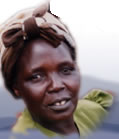 |
 |
||
 |
|||
|
RELATED THEMES environment land livestock OTHER LOCAL THEMES BACKGROUND |
agriculture
The land farmed by these narrators is fertile and productive, more so than most of the other sites featured in this website. As one narrator claims: "If you could go to my house during the harvest, there were so many sacks [of grain] all over, we had to push all chairs against the wall" (Kenya 2) . Several describe farming without any fertiliser at all, or using natural rather than chemical fertiliser: "Some parts of Mount Elgon are naturally fertile because it has a lot of waste matter. Therefore, there is no need to use artificial fertiliser, which are used on only exhausted land" (Kenya 3) . Almost everyone seems to be involved in agriculture in some way. Most people, even if they are not farming on a larger scale, will have a small family plot (shamba) to grow food, usually looked after by the wife. As one Bukusu narrator says, "in our tradition every woman had to have her own piece of land" (Kenya 21) . Many people mention owning farms even if they have another profession and again these sometimes scattered plots of land are the responsibility of the women in the family. This, as one narrator points out, is a major advantage of polygamy, though land shortages have now somewhat eroded this value. Indeed, pressure on the land is clearly an increasing problem in the area. The Sabaot though, were originally pastoralists, not farmers. Only in the last 50 years or so has agriculture gradually taken over from livestock as the main source of income in the area, with the introduction of cash crops such as maize and coffee. One Sabaot talks of how the neighbouring Bukusu and Teso taught them "this knowledge of cultivating other crops", and how before, the Sabaot only farmed for subsistence, planting sorghum, millet, bananas, cassava, and sweet potatoes. He goes on to emphasise the importance of crops such as coffee, because "now.we are in a position to get the cash when [the crops are] taken to the factory". Another states that before the Sabaot developed their agriculture, "things were very difficult, there was shortage of food nearly every time. There were times when people would even feed on banana stems. in spite of the frequent droughts in the past, the main cause of famine that time must have been the low productivity of the crops we used to cultivate. But today people have known better methods of farming which enable them to have a surplus" (Kenya 13) . The change in lifestyle seems to have been influenced not only by neighbouring agriculturalists, but also by a concerted government effort to shift the Sabaot from pastoralism to farming. Several narrators speak of an old government resettlement plan: "In the past, we used to stay up to inside of the forest. The government decided to move some of us down here. They felt that we would die of famine if we did not cultivate crops" (Kenya 20) . Others mention how agricultural extension services have helped them improve farming techniques. Yet several narrators feel agricultural development has only gone so far: poor roads and lack of local maize-buying centres makes it difficult for farmers to market their produce. More recently, the clashes of the early 90s forced many to flee their farms, leaving arable land lying fallow. One narrator, who lost her farm in this way, states: "You know a farm is never good nor productive after people have shed blood and criss-crossed with spears in it. It is a bad omen" (Kenya 2) . quotes about agriculture"People have tried to plant various crops like coffee, tea, but the impassable road still remains a dilemma and also lack of factories to process the raw materials." "...if you are a good farmer, when the maize and beans ripen, the children are able to get plenty of food and you can even sell to get some money to solve your financial problems. If you manage one dairy cow properly, it will give you so much milk for consumption and for sale. You can even supply the local hotels with milk. This life is better than the previous one." "Us the Sabaot have mainly been pastoralists. But a semblance of modern farming started penetrating this region from about 1930. Before this year we never even had ox-ploughs. This means that whatever little we cultivated, we only used hoes. Before 1930 we cultivated sorghum, millet, cassava and sweet potatoes, and this was purely for subsistence. But the most important food of all was milk.... "All of us have actually accepted modern methods of farming. The biggest problem for us now is lack of capital. This had frustrated our efforts to improve our farming. Today if a person does not cultivate his farm properly, it is not because he does not know how to cultivate but it is due to lack of resources to invest. The same applies to the use of certified seeds. Most of our traditional crops, like millet and cassava, have been relegated to the periphery and everyone would like to use high yielding crops like maize. Even when we look at our livestock today, the low yielding indigenous breeds are slowly being replaced, but not with grade cattle, which are expensive to maintain, but with crossbreeds. Crossbreeds might not produce a lot of milk like grade cattle, but they are better than our traditional stock." |
|